 | Have Yourself a Merry Little ChristmasJudy Garland |
Writer(s): Hugh Martin (music), Ralph Blane (lyrics) (see lyrics here) First Charted: December 30, 1944 Peak: 27 PM, 2 DF (Click for codes to charts.) Sales (in millions): -- Airplay/Streaming (in millions): -- radio, 5.6 video, 160.0 streaming |
Awards:Click on award for more details. |
About the Song:The 1944 MGM musical Meet Me in St. Louis is set in 1903 leading up to the World’s Fair in St. Louis the following year. The movie featured some songs from the period as well as new material by composer Hugh Martin and lyricist Ralph Blane. Among the songs was “The Trolley Song,” which nominated for an Oscar for Best Song, and “Have Yourself a Merry Little Christmas,” a now holiday classic named to the American Film Institute’s list of top 100 movie songs. In the film, Judy Garland’s family is moving to New York, against the wishes of everyone except the father. Her sister is worried Santa won’t find her in their new home. Garland sings “Have Yourself a Merry Little Christmas” to her. She refused to perform the song as it was originally written because it was “too somber, too full of pain” TY1 with original lyrics “Have yourself a merry little Christmas / It will be your last / Next year we will be living in the past.” TY1 The director Vincente Minnelli and her co-star Tom Drake agreed and the lines were changed to “Let your heart be light / Next year all our troubles will be out of sight.” WK The suggestion that things would be better the next year resonated with United States troops during World War II. When she performed the song at the Hollywood Canteen, it brought many soldiers to tears. WK Although Blane and Martin were credited with the songs in Meet Me in St. Louis, Martin has claimed that he wrote the music and lyrics to most of the songs. He said he allowed Blane credit because of “my naïve and atrocious lack of business acumen.” WK Despite becoming such a Christmas favorite, “Have Yourself a Merry Little Christmas” went nearly fifty years from Garland initially charting with the song in 1944 before it charted again. Vince Gill hit #52 on the country chart with it in 1993. Others to chart with it include Kenny G (1994, #26 AC), Martina McBride (1999, #53 CW), James Taylor (2001, #4 AC), Ruben Studdard & Tamyra Gray (2003, #25 AC), Clay Aiken (2005, #32 AC), Joe Nichols (2005, #57 CW), LeAnn Rimes (2005, #60 CW), Sarah McLachlan (2006, #6 AC), Barry Manilow (2007, #11 AC), Colbie Caillat (2009, #12 AC), David Archuleta (2009, #22 AC), Katharine McPhee (2010, #16 AC), Michael Bublé (2011, #47 BB, 99 UK, 9 AU), Rod Stewart (2012, #28 AC, 51 UK), Little Big Town (2012, #49 CW), Susan Boyle (2013, #17 AC), Sam Smith (2014, #90 BB, 50 RR, 6 AC), Dan + Shay (2014, #17 AC), Train (2015, #5 AC), Josh Groban (2016, #1 AC), John Legend with Esperanza Spalding (2018, #1 AC), and the Rua (2018, #25 AC). Resources:
Related Links:First posted 12/21/2023. |








